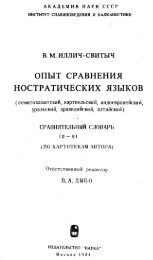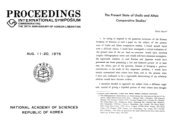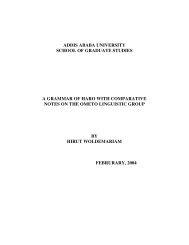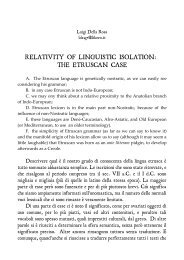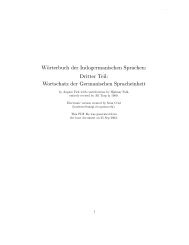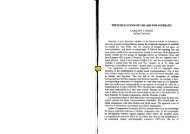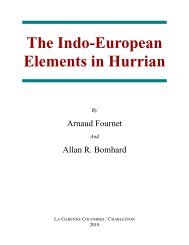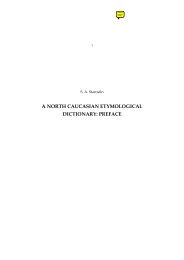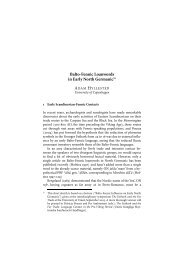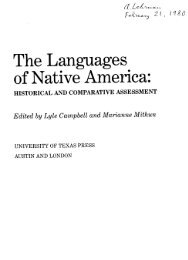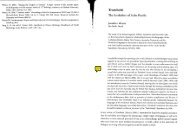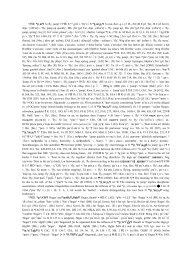(196)blench - tasmanian.pdf
(196)blench - tasmanian.pdf
(196)blench - tasmanian.pdf
Create successful ePaper yourself
Turn your PDF publications into a flip-book with our unique Google optimized e-Paper software.
Classifications of the Tasmanian languages in relation to the peopling of<br />
Australia: sensible and wild theories<br />
Roger Blench<br />
Mallam Dendo<br />
8, Guest Road<br />
Cambridge CB1 2AL<br />
United Kingdom<br />
Voice/ Fax. 0044-(0)1223-560687<br />
Mobile worldwide (00-44)-(0)7967-696804<br />
E-mail R.Blench@odi.org.uk<br />
http://www.roger<strong>blench</strong>.info/RBOP.htm<br />
‘The origin of the Tasmanian aborigines has been subjected to nearly as much consideration as the<br />
origin of mankind. The discussion has been extended over a long time; the resulting opinions have<br />
been characterized by much uncertainty, due partly to the paucity of the known facts.’<br />
Wunderly (1938)<br />
‘There is no hint of a relationship with languages from any other part of the world….Greenberg’s is<br />
one of the more outrageous hypotheses that have been put forward concerning the Tasmanian<br />
languages.’<br />
1. Introduction<br />
(Crowley & Dixon 1991:420)<br />
The Tasmanians probably crossed the Bass Strait to the island of Tasmania some 40,000 years ago and were<br />
there cut off by a rise in sea-levels 10-12,000 years ago (O’Connor & Chappell 2003:21). Their distinctive<br />
languages and cultures were cut short by an appalling genocide in the middle of the 19 th century and the last<br />
full-blooded Tasmanian, Truganini, died in 1876. The Tasmanian languages are believed to have became<br />
extinct in 1905, with the death of the last known speaker, Fanny Cochrane Smith. Wax cylinder recordings<br />
were made of her speech, but their quality is so poor that little can be made of them, and moreover, doubt<br />
exists as to the unmixed nature of her speech. Records of the Tasmanian languages are fragmentary and<br />
incomplete as well as being doubtfully transcribed. As a consequence, but their actual affiliations will<br />
probably remain unknown (Crowley & Dixon 1991). Terry Crowley records the efforts made to record<br />
individual lexical items from ‘rememberers’ after 1905, and since 1999 there has been an attempt to revive<br />
the language, at least to the extent of using whatever specialised lexicon remains, particularly words<br />
connected with the seashore and the marine environment 1 . But what these words represent is uncertain since<br />
the communities on the Hunter islands were artificial, brought together by missionaries from different bands<br />
and the speech may have been a creole.<br />
Apart from the languages, the Tasmanians themselves were the subject of much ethnological curiosity in the<br />
nineteenth century because of their distinctive physique, curly hair and a culture characterised by absences<br />
(inability to make fire, taboo on eating scale-fish and other technologies recorded on the mainland). Even<br />
before the death of Truganini, anthropologists had begun to speculate on the origin of the Tasmanians<br />
(Huxley 1868; Bonwick 1870) and this soon led to an unseemly scramble for osteological relics<br />
characterised by skulduggery practised on behalf of very august institutions in the quest for skulls (this<br />
disgraceful episode is recounted in the film, The Last Tasmanian made by Tom Haydon in 1978). One of the<br />
largest collections of Tasmanian skulls was blown to pieces when a bomb fell on the Royal College of<br />
Surgeons during the Second World War. Only in recent years has there been some restitution, with the<br />
reburial of Truganini and the return of other Tasmanian materials to the descendants of the last survivors.<br />
1<br />
See http://www.fatsil.org/LOTM/dec99.htm#book#book A counting book with numbers up to one million in<br />
Tasmanian has been created, perhaps a text of limited application.<br />
1
Clearly there are puzzling issues in understanding the affiliations, both linguistic and genetic, of the<br />
Tasmanian peoples, but for every sober appraisal in the literature, there is a discourse from a parallel<br />
universe, one where anything is possible. The Tasmanians have become a mirror for unlikely hypotheses, a<br />
reflection of the pre-occupations of the times and a rich fabric woven with fantasy. Moreover, this is not a<br />
nexus that can be safely consigned to the nineteenth century; in 2004 an article in the PNAS proposed to link<br />
the languages of Tasmania with Kusunda, a language isolate in Nepal. This paper can only peer briefly into<br />
these swirling mists.<br />
2. Early theories<br />
First contact with the Tasmanians was in 1642, but<br />
it was not until the second quarter of the nineteenth<br />
century, a crucial period for a nascent anthropology<br />
in general, when exploration was coming to an end<br />
and the study of indigenous peoples began in<br />
earnest. The crucial puzzle, as it appeared at the<br />
time, was the physical distinctiveness of the<br />
Tasmanians, especially as regards their hair.<br />
Huxley (1868) argued that the Tasmanians and<br />
Australians were distinct physical types and that<br />
the affinities of the Tasmanians were with the<br />
negritos, whose most proximate representative,<br />
according to Huxley, were in New Caledonia.<br />
Since there was no trace of such populations on the<br />
Australian mainland, and such a long sea-voyage<br />
unlikely, they must have journeyed by using nowdisappeared<br />
islands in the Tasman Sea as stepping<br />
stones (Figure 1). Such a theory had no geological<br />
basis and was in fact no more credible than Plato’s<br />
Atlantis, but was opposed only by those who<br />
considered the New Caledonian origin credible but<br />
supposed that a sea-voyage was possible (Wood-<br />
Jones 1935).<br />
Figure 1. Tasmania peopled from New Caledonia?<br />
Another solution to the problem of negrito types in the Pacific was canvassed by Allen (1879), who thought<br />
that they probably hopped across the Indian Ocean on a now conveniently sunken land ridge (Figure 2);<br />
‘though the Negro is now almost confined to Africa, and is not migratory, yet formerly a ridge of land<br />
ran viâ Madagascar, the Seychelles, and across to Borneo, and hence there was a path for the mixture<br />
of races. The submergence of the ridge, leaving now only the tops of hills above the water, had<br />
isolated the Negro and Malay again.’<br />
Allen (1879)<br />
Sadly, this conceptual high-point sank beneath the waves likes its geological counterpart, leaving the nonmigratory<br />
Negroes trapped in Africa.<br />
Wunderly (1938) summarises the various theories concerning the origin of the Tasmanians held prior to the<br />
Second World War;<br />
1. That they were autochthonous<br />
2. That they travelled to Tasmania via Antarctica<br />
3. That they arose from the Melanesians, and journeyed more or less directly from an island in<br />
Melanesia to Tasmania, the probable island of origin most frequently referred to being New Caledonia.<br />
4. That they were Asiatic Negritos, who migrated to Tasmania via the Australian mainland.<br />
2<br />
Australia<br />
Coral Sea<br />
Tasmania<br />
Vanuatu<br />
New Caledonia<br />
N<br />
Tasman Sea
Figure 2. Migration route of Negroes out of Africa, across the mid-Indian Ocean ridge<br />
Nyam-nyam<br />
(S. Sudan)<br />
mid-Indian Ocean ridge,<br />
now sunken<br />
Of these, the most immediately Figure 3. The peopling of Tasmania: the Antarctic route<br />
attractive view is the Antarctica<br />
hypothesis (Figure 3), its only defect<br />
being the lack of a starting point<br />
(Cape Horn? The Cape of Good<br />
Hope?). But one may imagine the<br />
Tasmanians skirting the ice floes and<br />
spearing seals as they made their way<br />
from Patagonia. Wunderly observes<br />
‘the first and second of these views<br />
have been abandoned of lack of<br />
evidence’. Even the third view he<br />
eventually consigns to the dumpster<br />
of history together with all those<br />
sunken islands off the eastern shores of Australia.<br />
We are left with the fourth model, which is approximately what is believed today, if not expressed in those<br />
terms. The view that the Tasmanians reached their island from Australia by island hopping goes back to<br />
Bonwick (1870) and was reaffirmed in Ling-Roth’s (1899) massive compilation and by the work of Meston<br />
(1936). The issue then became whether the Tasmanians simply were Australians whose physical features<br />
had been changed by isolation, or whether they were remnants of a former Negrito race, whose Australian<br />
representatives had been eliminated by incoming Mongoloids. Still for Wunderly and other scholars of the<br />
period, the contrast between the woolly hair of the Tasmanians and the straight hair of the Australians<br />
remained a problem. Wunderly (1938:200) wisely observed that ‘undue weight should never be allotted to a<br />
single characteristic, especially of a superficial nature, when attempting to trace racial origins’. Nonetheless,<br />
he proposed to resolve the issue by a ‘practical enquiry’ by crossing a ‘Mongoloid and a Negroid’.<br />
Without resorting to Wunderly’s ethically dubious solution, this issue continues to spark debate.<br />
Archaeological evidence has provided a sufficient demonstration that Tasmania was settled from Australia<br />
and for most authors, physiognomic differences are merely a consequence of genetic isolation (e.g. Turner<br />
1914; Tiegs 1927; Ryan 1981). Although skull-morphometrics have a poor reputation these days, it is worth<br />
recording that early studies of Australian and Tasmanian crania reached exactly the same conclusion. Was it<br />
then the case that the Tasmanians were a relic of an earlier wave of the peopling of Australia? This view had<br />
been espoused, to a broad chorus of disapproval, by the geographer Griffith Taylor (1927). Two historians,<br />
3
Keith Windschuttle and Tim Gillin (2002) have re-opened this debate under the challenging title The<br />
extinction of the Australian pygmies. Windschuttle is a historian who has made a career debunking postmodern<br />
retellings of history, but most of his targets have been more conventional; the refashioning of the<br />
Aztecs into gentle victims of circumstance and the like. But he takes on the prehistory of Australia in<br />
typically robust fashion. Broadly speaking, the claim is that there is an earlier literature which has been ‘airbrushed’<br />
out of academic accounts of Aboriginal Australia, describing short-statured peoples in the<br />
Queensland rain-forest. Once known as the ‘Barrineans’ after Lake Barrine, the peoples in question were the<br />
Djabuganjdji, Mbarbaram (Barbaram) and Yidinjdji (Indindji). The first evidence for the unusual<br />
characteristics of these people was gathered by the physical anthropologists, Norman Tindale and Joseph<br />
Birdsell in 1938, following up on some striking photographs 2 . Tindale & Lindsay (<strong>196</strong>3) summarised the<br />
results of their research as follows; ‘their small size, tightly curled hair, child-like faces, peculiarities in their<br />
tooth dimensions and their blood groupings showed that they were different from other Australian<br />
Aborigines and had a strong strain of Negrito in them’ and made an explicit comparison with the<br />
Tasmanians. In the meantime, Birdsell (<strong>196</strong>7) was propagating the ‘trihybrid’ theory according to which<br />
Australia had been subject to three waves of peopling, the first of which were Negritos, whose only<br />
remnants were the Barrineans and the by-then extinct Tasmanians. The Negritos were eliminated or<br />
assimilated by two further waves, the Murrayians (said to resemble the Ainu) and the Carpenterians (Veddas<br />
exiled from Sri Lanka). Bizarrely, this theory was celebrated in a children's book narrating the journey of a<br />
pygmy family walking into Australia (Tindale & Lindsay 1954).<br />
It is safe to say, that despite a long-running and doughty defence by Birdsell, this has not been incorporated<br />
into mainstream accounts of the prehistory of Australia. Flood (1999) and Mulvaney & Kamminga (1999)<br />
both dismiss the tribybrid theory as irrelevant to modern accounts. According to Windschuttle and Gillin<br />
(2002) this is in part not an evidence-based view, but simply a reflection of a dominant ideology within the<br />
academic system. The growth of pan-Aboriginalism encouraged a simplified narrative of one people whose<br />
land was stolen by intrusive Europeans. At the same time, increasing scepticism about the results of physical<br />
anthropology and the realisation of the range of variation that can co-exist within contemporaneous<br />
populations made it seem ever more unlikely that the taphonomic evidence would uncover incontrovertible<br />
evidence for the waves proposed by Birdsell.<br />
Nonetheless, it does seem that there are also problems for those espousing homogeneity and highly local<br />
evolution to explain the situation. In many ways this issue strongly resembles the debate over the peopling<br />
of the Americas. For decades, American archaeologists have asserted the homogeneity and late date of New<br />
World populations, relating this to a mythological opening and closing of an ice-free corridor across the<br />
Bering Strait. In the face of mounting evidence for the earlier dates and physical diversity of Amerindian<br />
populations and in particular their ethnolinguistic diversity, ever more strained arguments have had to be<br />
deployed. The underlying logic appears to be much the same; the need for a unitary narrative of European<br />
imperialism. But undisputed early dates for Siberia, combined with contemporary ethnographic evidence,<br />
point to continuous flow of populations following the southern edge of the ice-floes, using small boats to<br />
bridge any gaps. Given that Siberia is notorious for ethnolinguistic diversity it should be quite unsurprising<br />
that the New World reflects this situation, if magnified a hundredfold.<br />
So with Australia. Once the way was opened, as much as 55,000 BP, nothing prevented the arrival of<br />
different populations from different regions with different physical characteristics. The diverse and hard-toclassify<br />
languages of the northeast point strongly to such a pattern (Harvey 1997). Results from mtDNA<br />
analyses can be a two-edged sword, but as far as recent studies go, they point to similar multiplicity. Redd &<br />
Stoneking (1999:808) say ‘These mtDNA results do not support a close relationship between Aboriginal<br />
Australian and PNG populations but instead suggest multiple migrations in the peopling of Sahul’. The<br />
peopling of Australia was probably both fragmented and occurred over a long period; there is nothing to<br />
suggest that remnant populations might not have survived until the near-present just as the Hadza and the<br />
Kwadi in Africa tell of a much greater prior diversity (Blench 2006). The Barrineans might be ‘Tasmanoids’<br />
2<br />
One of these, taken of an encampment near Cairns in 1890, shows a group of individuals in front of a banana-leaf<br />
shelter that is irresistibly reminiscent of African rain-forest pygmies. As Windschuttle and Gillin (2002) point out, it is<br />
only with a scale that allows you to see the average height of the population is only about 145 cm. that the image<br />
becomes really striking.<br />
4
or they might be unconnected; constructing the debate as a war between single and multiple wave theories<br />
probably generates more heat than light.<br />
3. Greenberg and Indo-Pacific<br />
Disappointingly for Tindell and Windschuttle, the languages of the Barrineans appear not to be distinctive,<br />
or at any rate to resemble closely those of neighbouring full stature peoples. However, to try and bolster<br />
their argument, Windschuttle and Gillin (2002) unfortunately make appeal to one of the more improbable<br />
macrophyla hypotheses in linguistics, the ‘Indo-Pacific’ theory of Joseph Greenberg. Greenberg is known<br />
principally for his classification of African languages and more recently for his attempt to shoehorn New<br />
World languages into three phyla (Greenberg <strong>196</strong>3, 1987). But in Greenberg’s (1971) Indo-Pacific theory he<br />
discerned connections between Andamanese, most Papuan languages and Tasmanian. Although this<br />
purported to be a purely linguistic exercise but it conveniently swept up all the languages of the crinklyhaired<br />
populations in the region that were not clearly Austronesian.<br />
Indo-Pacific is one of the more recent attempts to try and find a linguistic relative of the Tasmanian<br />
languages. The earliest attempt at a synthesis I can trace is Latham’s Appendix to Jukes’ (1847) Narrative of<br />
the surveying voyage of H.M.S. Fly. Latham observes;<br />
a) The Tasmanian language is fundamentally the same for the whole island although spoken in not<br />
less than four dialects mutually unintelligible<br />
b) It has affinities with the Australian<br />
c) It has affinities with the New Caledonian<br />
It is doubtful whether the affinities between the Tasmanian and Australian are stronger than those<br />
between the Tasmanian and New Caledonian.<br />
These views are reprised in Latham’s (1862) Elements of Comparative Philology and suggest that Huxley<br />
(see above) was aware of them when propounding his own branch of island hopping.<br />
Still more wayward views began to be expounded; in a comment on Allen (1879:49), a Mr. Hyde Clarke<br />
observed ‘Then there was the curious circumstance that in the Tasmanian languages were traces of the<br />
Nyam-Nyam of the African Lake Regions’. Curr (1886-7) generally a respected scholar, saw as many<br />
Tasmanian cognates with African languages as with the languages of the nearby mainland. Schmidt (1952)<br />
provides a valuable overview of the main waypoints in Tasmanian language scholarship as well a being the<br />
first near-complete synthesis of sources. Plomley (1976) sets out the data known up to that point without<br />
advancing any hypothesis concerning the affiliations of Tasmanian. His work was completed by Crowley &<br />
Dixon (1991) who provide the most complete outline of the likely phonology and morphology of Tasmanian.<br />
Greenberg’s work on African languages gained him many supporters and non-specialists frequently<br />
supposed that the linguistic community might come round to Indo-Pacific, after a suitable interval. But this<br />
has turned out to be a forlorn hope; Indo-Pacific has met with almost no assent from specialists in the field.<br />
In an evaluation of this theory, Wurm (1975) noted some resemblances between West Papuan and<br />
Andamanese. However, additional decades of data on Papuan and a recent synthesis of Papuan prehistory<br />
(Pawley et al. 2005) has not increased support for the Indo-Pacific hypothesis. So can Indo-Pacific be<br />
consigned to a Sargasso Sea of dissolved theories? Unfortunately not; a high-profile publication in the<br />
Proceedings of the National Academy of Sciences shows that it lives on in unexpected ways (Whitehouse et<br />
al. 2004). In part, their abstract reads;<br />
The Kusunda people of central Nepal have long been regarded as a relic tribe of South Asia. They are,<br />
or were until recently, seminomadic hunter-gatherers, living in jungles and forests, with a language<br />
that shows no similarities to surrounding languages. Our research indicates that the Kusunda<br />
language is a member of the Indo-Pacific family.<br />
5
The evidence, as so often in these cases, turns out to be lexical. I quote below the very small number of<br />
cases that incorporate Tasmanian examples;<br />
Short. Kusunda potoǝ Indo-Pacific: Fayu bosa ‘‘small,’’ Sehudate buse ‘‘small,’’ Monumbo put,<br />
Bahinemo bɔt h a, Northeast Tasmanian pute ~ pote ‘‘small,’’ Southeast Tasmanian pute ‘‘small,’’<br />
Middle Eastern 3 Tasmanian pote ‘‘small.’’<br />
Unripe. Kusunda kátuk (H) ‘‘bitter,’’ qatu ‘‘bitter’’= Indo-Pacific: Kede kat ‘‘bad,’’ Chariar kedeŋ<br />
‘‘bad,’’ Juwoi kadak ‘‘bad (character),’’ Moi kasi, Biaka kwatǝkǝ ‘‘green,’’ Grand Valley Dani<br />
katekka ‘‘green,’’ Foe k h asigi, Siagha kadaɣai, Kaeti ketet, Orokolo kairuka ‘‘green,’’ Doromu kati,<br />
Northeast Tasmanian kati ‘‘bad,’’ Southeast Tasmanian kati ‘‘bad.’’<br />
This may seem a curious choice of words for Indo-Pacific speakers to carry from the Himalayas, but motives<br />
in prehistory are always somewhat obscure. Similarly obscure was the choice of journal in which to publish<br />
this controversial thesis, a journal so unused to linguistics that it appears not to possess the correct fonts to<br />
print phonetic characters properly.<br />
Indo-Pacific only exists in the eye of the believer and most believers have been Greenberg acolytes such as<br />
Merrit Ruhlen or archaeologists such as Colin Renfrew. Those most in a position to evaluate the hypothesis<br />
have given a resoundingly negative verdict. This is not the hidebound conservatism of an establishment<br />
unable to accept the bold ventures of long-rangers but a rational critique based on long experience of the<br />
detailed evidence.<br />
This should not disappoint us; the efforts of early classifiers, in an era when there was no real evidence for<br />
time-scales, should be seen in a sympathetic light. But since we now know that Tasmania was occupied as<br />
much as 40,000 years ago, there is no reason to assume its languages have not been developing a distinctive<br />
character during most of that period. It is highly improbable that they should now show demonstrable links<br />
with their nearest relatives, even assuming that these could be determined. Attempts to have the world’s<br />
isolate language groups cavort promiscuously on a Procrustean bed of macrophyla are attractive after the<br />
perverse fashion of late-night television, but should not distract us from more serious tasks. We cannot know<br />
that Nepalese hunter-gatherers did not wander across half the world in deep time carrying a word for ‘small’,<br />
but it is hardly worth proceeding on the assumption that this is so.<br />
References<br />
Allen, Francis A. 1879. The Original Range of the Papuan and Negritto Races. The Journal of the<br />
Anthropological Institute of Great Britain and Ireland, 8:38-50.<br />
Birdsell, J.B. <strong>196</strong>7. Preliminary data on the trihybrid origin of the Australian Aborigines", Archaeology and<br />
Physical Anthropology in Oceania, 2 (2), , pp 100-55<br />
Blench, R.M. 2006. Archaeology, Language and the African Past. Lanham – New York – Toronto<br />
– Oxford: Altamira Press.<br />
Bonwick, J. 1870. Daily life and origin of the Tasmanians. London: Sampson, Low, Son and Marston.<br />
Crowley, T. & R.M.W. Dixon 1981. Tasmanian. In: Handbook of Australian languages, Volume 2. R.M.W.<br />
Dixon and B.J. Blake eds. 394-427. Canberra: Australian National University Press.<br />
Curr, E.M. 1886-7. The Australian Race; its origin, languages, customs, places of landing in Australia, and<br />
the routes by which it spread itself over that continent. [4 vols.] Melbourne: Victorian Government<br />
Printer.<br />
Flood, Josephine 1999. Archaeology of the Dreamtime: The story of prehistoric Australia and its people,<br />
Sydney: Angus and Robertson.<br />
Greenberg, J.H. <strong>196</strong>3. The Languages of Africa. The Hague: Mouton.<br />
Greenberg, J.H. 1971. The Indo-Pacific hypothesis. In: Current Trends in Linguistics, Volume VIII -<br />
Linguistics in Oceania. T.A. Sebeok (ed.) 807-871. The Hague: Mouton.<br />
Greenberg, J.H. 1987. Language in the Americas. Stanford, CA: Stanford University Press.<br />
3<br />
‘Middle Eastern’ here does not indicate some as yet unacknowledged Semitic input into Tasmanian.<br />
6
Griffith Taylor, T. 1927. Environment and Race: A study of the evolution, migration, settlement and status of<br />
the race of man. London: Oxford University Press.<br />
Harvey, Mark 1997. The temporal interpretation of linguistic diversity in the Top End. In: Archaeology and<br />
Linguistics: Aboriginal Australia in Global Perspective. P. McConvell & N. Evans eds. 179-186.<br />
Melbourne: Oxford University Press.<br />
Huxley, T.H. 1868. The distribution of the races of mankind and its bearing on the antiquity of man.<br />
International Congress of Prehistoric Archaeology.<br />
Jukes, Joseph B. 1847. Narrative of the surveying voyage of H.M.S. Fly. [2 vols.] London: T. & W. Boone.<br />
[Discussion by Latham on Tasmanian languages, p. 319].<br />
Latham, R.G. 1862. Elements of Comparative Philology. London: : Walton and Maberly.<br />
Ling-Roth, H. 1899. The aborigines of Tasmania. [2 nd ed.] Halifax: King & sons.<br />
Meston, A.L. 1936. Observations on visits of the Tasmanian Aborigines to the Hunter Islands. Proc. of the<br />
Royal Society of Tasmania for 1935. pp. 155-62.<br />
Mulvaney, John and Johan Kamminga 1999. Prehistory of Australia. Sydney: Allen and Unwin.<br />
O’Connor, S. & J. Chappell 2003. Colonisation and coastal subsistence in Australia and Papua New Guinea:<br />
different timing, different modes? In C. Sand, ed. Pacific archaeology: assessments and anniversary of<br />
the first Lapita excavation (July 1952) Koné, Nouméa, 2002. 17-32. Les Cahiers de l’Archéologie en<br />
Nouvelle-Calédonie, Nouméa, New Caledonia.<br />
Pawley, Andrew, Robert Attenborough, Jack Golson and Robin Hide eds. 2006. Papuan Pasts: Cultural,<br />
linguistic and biological histories of Papuan-speaking peoples. Canberra: Pacific Lionguistics.<br />
Plomley, Norman J. B. 1976. A Word-List of the Tasmanian Aboriginal Languages. Launceston: Published<br />
by the author in association with the Government of Tasmania.<br />
Redd, A.J. & M. Stoneking 1999. Peopling of Sahul: mtDNA variation in Aboriginal Australian and Papua<br />
New Guinean populations. American Journal of Human Genetics, 65:808-828.<br />
Ryan, L. 1981. The aboriginal Tasmanians. St. Lucia: University of Queensland Press.<br />
Schmidt, Wilhelm 1952. Die Tasmanischen Sprachen. Utrecht-Anvers: Spectrum.<br />
Tiegs, O.W. 1927. The supposed distinction of Australian Aborigines into Straight and Wavy Haired<br />
Individuals. Australian Journal of Experimental Biology and Medical Science, 4.<br />
Tindale, Norman and H. A. Lindsay 1954. The First Walkabout. London: Longmans Green.<br />
Tindale, Norman and H. A. Lindsay <strong>196</strong>3. Aboriginal Australians. Brisbane: Jacaranda Press.<br />
Turner, W. 1914. The aborigines of Tasmania. Part 3. The hair of the head. Transactions of the Royal<br />
Society of Edinburgh, 50:309-347.<br />
Whitehouse, Paul, Timothy Usher, Merritt Ruhlen, and William S.-Y. Wang 2004. Kusunda: An Indo-<br />
Pacific language in Nepal. PNAS, 101(15): 5692-5695.<br />
Windschuttle, Keith & Tim Gillin 2002. The extinction of the Australian pygmies. Quadrant. Not paginated.<br />
Available at; http://www.sydneyline.com/Pygmies%20Extinction.htm<br />
Wood-Jones, F. 1935. Tasmania’s vanished race. Sydney.<br />
Wunderly, J. 1938. The Origin of the Tasmanian Race. Man, 38:198-203.<br />
Wurm, S.A. 1975 (ed.). New Guinea area languages and Language study. Volume I: Papuan languages and<br />
the New Guinea linguistic scene. Pacific Linguistics C-38. Canberra: Australian National University.<br />
7



